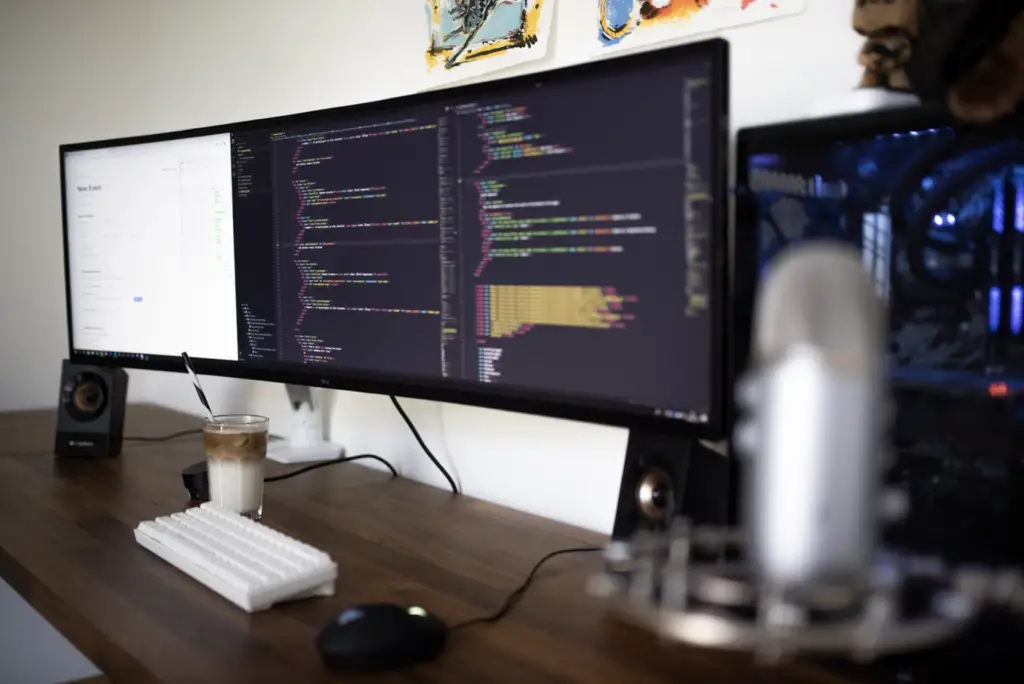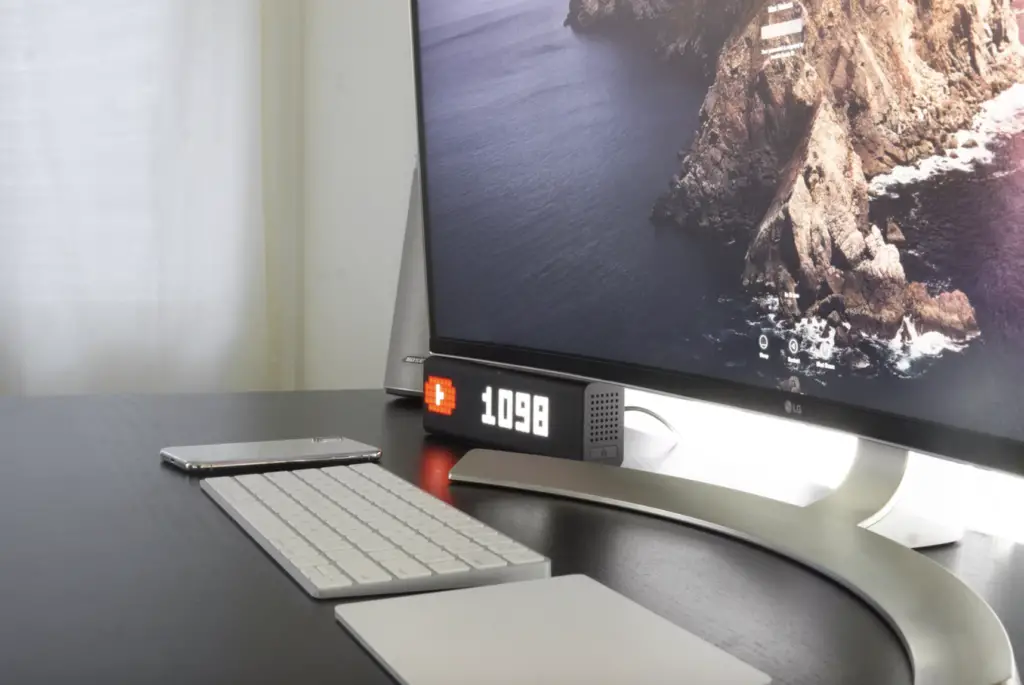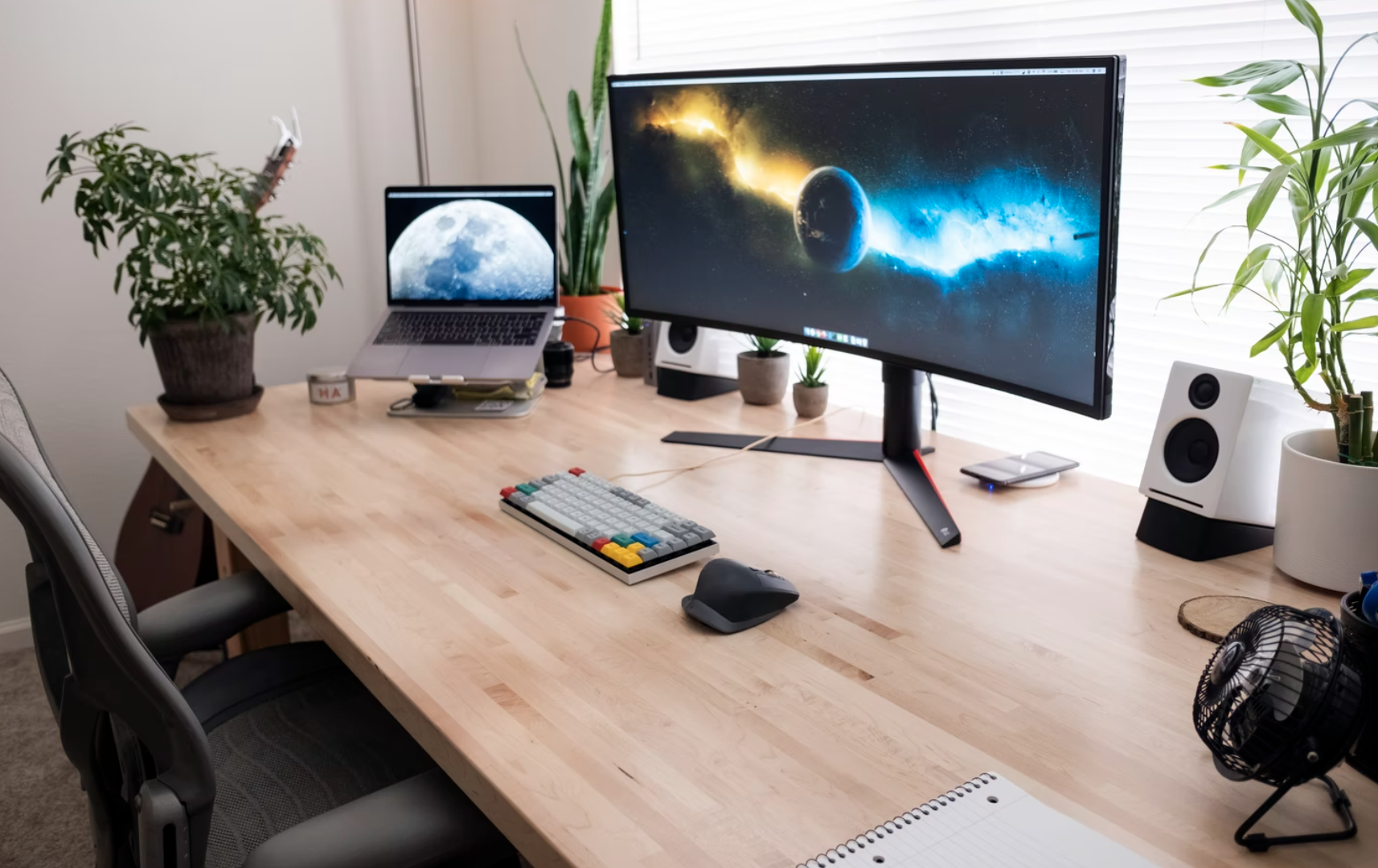Curved monitors are becoming increasingly popular. While only a few models were available until recently, you can now choose from various manufacturers and monitors. Gaming fans have also discovered curved monitors for themselves. Ready to go curvy? Let’s explore curved monitors in more detail and see their advantages over flat screens.

Advantages of curved monitors over flat screens
The term “curved” means something like curved or arched. In contrast to flat screens, the screen on curved monitors is slightly curved inwards. This enables the design typical of curved monitors. In addition to the visual aspect, these monitors offer several advantages over flat screens.
Since the screen’s curvature is based on the curvature of the human eye, the viewing experience is significantly improved. The images on the monitor are less distorted. This is because the interpupillary distance to the center and sides of the screen is approximately the same. The improved viewing angle also makes the images look much more natural.
The viewer can also see the entire monitor. This makes curved monitors ideal for multitasking applications. Relaxed work over a more extended period of time is also possible with the monitors.
Due to the enlarged field of vision, the eyes have to move less and are relieved. In addition, they often have a matt display, which is also easy on the eyes.
This makes curved monitors ideal for office work. However, the biggest advantage these monitors offer is that the curvature creates a spatial effect. The viewer becomes part of what is happening on the screen.
There are various websites on the Internet that offer a complete overview of the advantages of curved monitors.
Curved monitors offer panoramic views
In the field of visual media, the panoramic view is the top standard, according to which everything is based.
If a product manages to make viewers practically “forget” that they are staring at a screen, it is very likely to become a bestseller.
For this, products must be designed in such a way that reality is reproduced as precisely as possible. This is especially true with regard to the perception of the eyes.
Everyone learns at a young age that we perceive the world around us in three dimensions: length, width, and height.
Everything would appear flat if our collective reality were based on only two dimensions. This is where the duel between curved and flat monitors begins.
Curved monitors use all three dimensions and peripheral vision; this enables the panoramic view. In contrast, the panorama experience is weaker with flat monitors that only consider two sizes and disregard peripheral vision.
Curved monitors cover a wider field of vision
If you learn about curved and flat monitors, you will find that the technical data of curved screens often show a connection between the panoramic view of a curved monitor and its higher-quality field of view.
In principle, this is due to the same reasons that curved screens are easier on the eyes than flat ones.
Since a curved screen directs light from all angles to the eye of the beholder, you can see everything at once without having to strain your eyes too much. This makes it easier for your eyes to cover a larger field of view than with flat screens; In short: Curved monitors look bigger.
Another benefit of having a wider field of view is that it also increases the panoramic view you can see.

Curved monitors are easier on the eyes
The same physical features that ensure that curved screens have less distortion also make them easier on the eyes.
Thanks to the curvature of the monitor, our eyes can see everything at once and are therefore less stressed.
In the case of flat screens, on the other hand, depending on the size, the eyes can be strained more if the screen goes beyond the natural field of view of a viewer.
In everyday life, we perceive situations completely naturally without stress. With curved screens, even with large-format monitors, the eyes can see the entire screen surface at once and are protected thanks to this natural vision.
Overall, when comparing curved and flat monitors, you should consider that the eyes are less stressed with curved screens.
Curved monitors eliminate distortions
Just think about how annoying a blurry picture is. Then imagine what it would be like if this fuzziness wasn’t due to a poor internet connection but rather hardware issues.
Another example: think about how image quality suffers when you enlarge a video or photo. A considerable amount of distortion has to be accepted, especially at the edge.
When discussing the properties of curved and flat monitors, it must be taken into account that the above cases relate almost exclusively to flat monitors. Distortion like the one in the examples above can occur on screens of any size, but the larger the monitor, the more noticeable it is.
Lower distortion is one of the advantages that curved monitors offer compared to flat monitors, as curved screens minimize distortion.
There is a very simple explanation for this. The different distortion in curved and flat screens is due to the physical laws of light projection.
To put it simply: Flat screens radiate the image in a straight line, directly at the viewer and past the viewer to the side. Curved screens, on the other hand, direct everything towards the viewer thanks to their curved shape and thus achieve less distortion.

Disadvantages of curved monitors
Nothing is absolutely perfect – there is always a little catch.
While this applies primarily to claims that are too good to be true, it unfortunately also applies to a certain extent to curved monitors.
Fortunately, the disadvantages of curved screens are very limited and will certainly not ensure that buyers turn away and instead resort to flat screens.
Wall mounting of curved monitors
The main disadvantage of curved screens is that their shape makes wall mounting difficult. In contrast to flat screens, which nestle closely against the wall behind, curved screens require special brackets and special positioning.
Roughly speaking, with curved screens, care must be taken not to mount them too close to the wall. Tilting and rotating brackets and adjustable bracket arms do not prevent curved monitors from sticking out of the wall, but they are great for overcoming the assembly challenges in this context.
The good news is that this is primarily a superficial issue and does not affect performance.
Bezels
Due to the geometric characteristics of the curvature, curved monitors unfortunately often cause glare or reflections at certain viewing angles.
Flat screens project light at a single, uniform angle – with curved screens, there are countless angles.
With that in mind, it becomes clear that it is relatively easy to keep light sources away from a single angle, but hardly from many.
The best way to remedy this problem is to keep the screen away from as many light sources as possible – or use it when no other light sources are involved.
Are curved monitors good for gaming?
Curved monitors are particularly interesting for gaming fans. The players sit in the middle in front of the monitor and can see the entire screen. The enlarged effect of the picture and the improved depth effect literally allow the players to immerse themselves even deeper in the game.
The immersive effect of the images is supported by the most modern technology. Curved monitors are available in all common resolutions such as Full HD (1,920 x 1,080), QHD (2,560 x 1,440), UWHD (2,560 x 1,080) and Ultra HD (3,840 x 2,160).
Also interesting for gamers, curved monitors have a short response time and high refresh rate. This enables them to play without delay. Most monitors also have the common HDMI, DVI, and VGA connections to connect the gaming PC to the monitor.
The current top curved monitors for gaming fans include the Acer Predator Z271, Samsung S34E790C, LG 34UM67-P, or Asus PG348Q.

Best curved monitors for your purposes
Anyone who currently wants to buy a curved monitor can choose from a number of manufacturers and models. Therefore, you should compare different monitors and look at their technical data and customer opinions on the devices. The top manufacturers include Samsung, Dell, Acer, LG, and Asus.
Before buying, there are a few important questions to clarify. How big should the monitor be? What can the monitor cost? Is the monitor intended for playing games, watching films, or for daily work?
Depending on the application, different manufacturers and models come into question. Gaming fans should pay attention to a high refresh rate and low response time. The above models, such as the Acer Predator Z7271, LG 34UM67-P or Asus PG348Q are perfect as gaming monitors.
If you want to watch films more often on the curved monitor, you should use a larger model with 34 inches or more. High resolution and good color rendering are also crucial for film fans.
Models with an aspect ratio of 21: 9 also disappear the black edges of films. Among the suitably curved monitors for watching films are the Samsung S34EE790C, LG 34UM67-P, and Asus PG348Q.
If you want to buy a curved monitor for the office or at home, you should look around for an all-around monitor such as the Samsung S34E790C, LG 34UC98, or the inexpensive Samsung C27F396FHU.
For graphic designers and professional applications, on the other hand, the not entirely inexpensive Dell U3415W is a good choice.
Curved monitors are also available with LCD and LED technology, whether gaming, film, or office monitors. LCD displays are cheaper and a bit thicker. Those who like it even narrower and are willing to pay a little more opt for an LED monitor.

